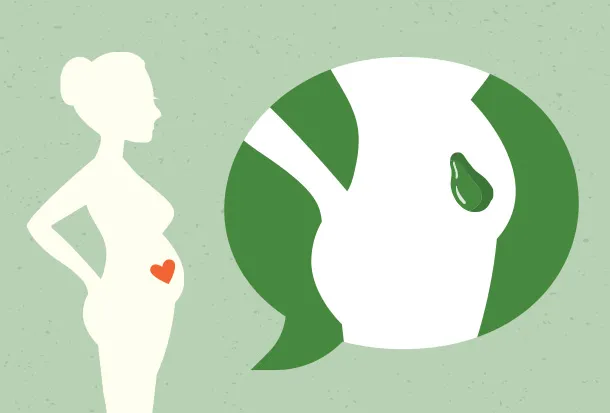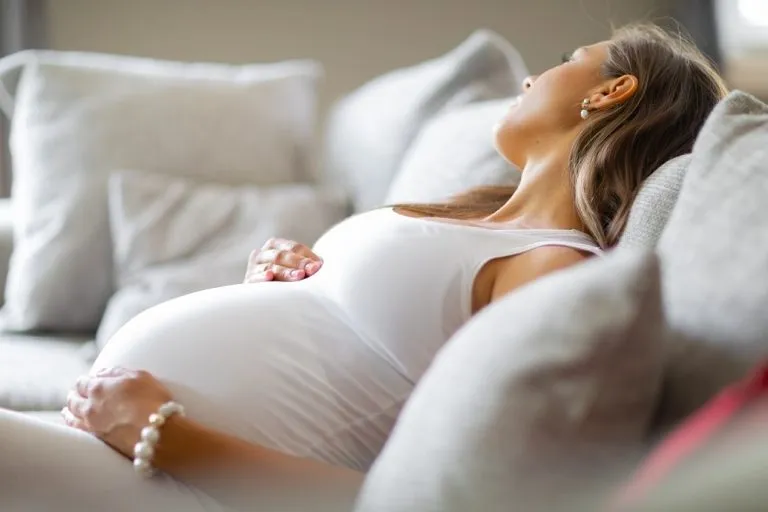W 13. The week of pregnancy the mother-to-be is accompanied by a marked increase in energy and a positive mood. Many women believe that this is the moment to enter the best time of waiting for an offspring. It is worth using it to bond with your little one, as well as to prepare your body for childbirth.
The first changes that can be seen in the 13. week of pregnancy
In many women, the abdomen at 13. week of pregnancy is already rounded and slightly convex, a visible sign of the growing life in their womb. During this period, the hips also widen, which is the body’s natural adaptation to future motherhood. As a result, you may find that some of your clothes become uncomfortable and no longer fit. Therefore, it is worth thinking about changing your closet to more spacious and flexible clothes to ensure your comfort in any situation – an important aspect of taking care of your own well-being during pregnancy.
Changes in the bust area are also often noticeable, as breasts often enlarge in preparation for future breastfeeding. This is a time when many moms-to-be are discovering a new dimension to their femininity. However, it is important to remember that any changes in the figure depend on the individual characteristics of each woman’s body. The variety of these changes underscores the uniqueness of each pregnancy and its experience.
The 13th week of pregnancy – which month and trimester is it?
The 13th week is the 4th. Month and the beginning of the second trimester of pregnancy. This is the time when the stage of rapid changes in the body of the mother-to-be has ended. And what is the development of the baby at 13 weeks of pregnancy? This is also the period when the child’s internal organs have already been formed, which is a significant step in the child’s development. These organs, while still developing, are beginning to function in a more organized manner.
Risk of miscarriage at 13. week of pregnancy clearly decreases, which brings relief to many parents-to-be. This is thanks to the placenta, which takes over the production of pregnancy hormones, playing a key role in maintaining the pregnancy. This organ, unique to pregnancy, not only supports the developing fetus, but also creates a special bond between mother and child.
It is worth noting that the beginning of the second trimester is often the moment when women begin to feel better, both physically and emotionally. This is the period when you can start planning for the future with your new family member, which often brings added joy and optimism.
How does a mother feel in the thirteenth week of pregnancy – the most common symptoms
W 13. A week into pregnancy, most women feel very well. Unpleasant pregnancy discomforts such as nausea or fatigue subside, and the belly is not yet large enough to make physical activity difficult or impossible. This is an encouraging time for moms-to-be to start or continue moderate physical activity. Walking, yoga for pregnant women or swimming are examples of safe forms of exercise. It is important that the workouts are not too intense and always consult the extent of the workouts with your doctor. Regular, moderate physical activity during pregnancy not only helps the body adapt to the changes taking place in it, but can also contribute to better well-being and fitness.
During this period woman at 13. The week of pregnancy may also see an increased appetite, as well as specific tastes for certain types of products. It is important to remember a balanced and rational diet. Although the popular belief is that a pregnant woman eats for two, the reality is somewhat different. The body’s energy requirements increase in the second trimester by only about 300 calories per day. A rational diet is recommended – eating wholesome meals rich in a variety of nutrients to support the healthy development of the baby and keep mom in good shape.
W 13. The week of pregnancy may show symptoms such as:
- constipation,
- heartburn,
- back pain,
- dizziness.
These are fairly common ailments that can be remedied through proper diet, exercise and rest. It is recommended that if these symptoms worsen, it is advisable to consult a health care provider who can suggest appropriate methods to alleviate the discomfort.
What does a child look like in 13. Week of pregnancy?
Child in 13. Week of pregnancy measures about 7 centimeters. Its weight is more than 20 grams, indicating a dynamic growth rate. Internal organs, such as the heart, liver, kidneys, and digestive system, are developing, but are not yet performing their full function. A fascinating aspect of this stage is that during this period the toddler swallows fetal waters, a key step in the development of the kidneys and digestive system.
Baby’s head at 13. week of pregnancy is still disproportionately large compared to the rest of the body, which is a typical developmental feature of fetuses during this period. The ears, nose and eyelids have already developed, allowing more distinct facial features to be outlined. An interesting phenomenon is the appearance of facial expressions – the toddler not only opens and closes his face, but can also yawn, frown, and even suck his thumb, which can often be captured during an ultrasound.
Baby’s movements in 13. Week of pregnancy are increasingly noticeable. With fully formed limbs and developing muscles, the toddler bends and straightens arms and legs, and turns. These active movements, while often hindering ultrasound, are a sign of healthy baby development. Nevertheless, these movements are not yet felt by the mother, which usually happens later in pregnancy.
Thirteenth week of pregnancy and the sex of the baby
Although around 13. A week into pregnancy, the genitals begin to form, the sex of the baby is still difficult to clearly determine. At this point in its development, the baby is still too small to accurately identify its gender by performing an ultrasound. Even experienced doctors may have difficulty accurately determining gender, as the accuracy of such observations during this period of pregnancy is estimated to be less than 50%. For this reason, many parents-to-be have to wait patiently for confirmation of the baby’s gender, which is usually only possible between 20. a 22. week of pregnancy.
This is the time when the fetus is already large enough to allow doctors to make more accurate observations. The development of the genitalia is then more advanced, which increases the accuracy and certainty of diagnosis. It is worth noting that the anticipation of this information can be an exciting part of the pregnancy journey for many Parents, adding an element of surprise and anticipation to the arrival of a new family member.
Prenatal ultrasound at this stage of pregnancy
The 13th week of pregnancy is the ideal time to schedule a prenatal ultrasound. This crucial test, performed with a specialized abdominal probe, allows the doctor to closely examine the developing fetus. During the examination, the doctor evaluates in detail the structure of the child’s head, torso, limbs and internal organs. This is of great importance for early detection of possible abnormalities.
In addition, fetal movements are observed and nuchal translucency is measured, which is an important indicator for assessing the risk of genetic and developmental defects. Prenatal ultrasound at 13. week of pregnancy provides valuable information about the baby’s health and can be a prelude to further, more detailed diagnostic tests, especially when irregularities are found.
It is also worth mentioning that this examination is also an opportunity for Parents-to-be to meet their baby. Seeing the movements and shape of the baby on the ultrasound screen often becomes one of the most emotional moments of pregnancy, strengthening the bond between Parents and the baby.
In the context of planning for the future health and safety of the child, it is also worth considering the option of collecting and storing cord blood after delivery. It is a source of valuable stem cells that can be used in the future to treat various diseases. The decision to donate cord blood is an investment in potential medical options for the child and the entire family.
FAQ:
- What changes in appearance and mood can be noticed in a woman at 13. Week of pregnancy?
The mother-to-be can slowly see the changing body in 13. week of pregnancy, as the belly rounds and the hips widen, requiring closet adjustments. Many women feel an increase in energy and improved well-being, the first pregnancy discomforts subside, and the belly is not yet large enough to impede physical activity.
- What is the size and weight of the baby at 13 weeks of pregnancy?
W 13. Week of pregnancy the baby measures about 7 cm and weighs more than 20 grams. Its internal organs are developing and beginning to function, and the head is disproportionately large in relation to the body. The child shows motor activity, including yawning and thumb sucking.
- What is the significance of prenatal ultrasound performed at 13. Week of pregnancy?
Prenatal ultrasound at 13. Week of pregnancy is crucial for assessing fetal health and development. Although these are not mandatory examinations, they allow a detailed assessment of the baby’s body structure, including the head, trunk, limbs and internal organs, and to monitor its movements. This test is also important in detecting early developmental and genetic defects.
Rate this article:










